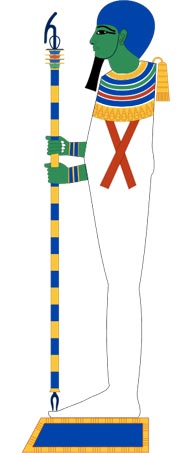About the Caches of the Gods
There are sixteen caches of the gods. Each cache contains a key to unlocking the special Pyramid Cryptex device which holds the secret location of the Pharaoh's Treasure (GC5JTAJ).
Twelve of the gods have true keys to the device, while four of the gods have false keys to mislead the careless adventurer. Each key can be found in the form of a symbol on the inside of the lid of the cache container.
The true keys must be discovered by visiting the god's caches and recording the key's image. once all twelve keys have been found you must determine their correct order and dial them into the levels of the Pyramid Cryptex.
If you successfully open the device, you will receive the final location of the Pharaoh's Treasure. If you are the first to open the device, your reward will be great indeed!
While not required, it is suggested that a digital camera to snap a shot of the keys for reference while solving the puzzle might be a good idea. Please do not share pictures of the keys with any other adventurers.
About Ptah

Ptah is the Creator god par excellence: He is considered the demiurge who existed before all things, and by his willfulness, thought the world. It was first conceived by Thought, and realized by the Word: Ptah conceives the world by the thought of his heart and gives life through the magic of his Word. That which Ptah commanded was created, with which the constituents of nature, fauna, and flora, are contained. He also plays a role in the preservation of the world and the permanence of the royal function.
In the Twenty-Fifth Dynasty, the Nubian pharaoh Shabaka would transcribe on a stela known as the Shabaka Stone, an old theological document found in the archives of the library of the temple of the god at Memphis. This document has been known as the Memphite Theology, and shows the god Ptah, the god responsible for the creation of the universe by Thought and by the Word.
Ptah is the patron of craftsmanship, metalworking, carpenters, shipbuilders and sculpture. From the Middle Kingdom onwards, he was one of five major Egyptian gods with Ra, Isis, Osiris and Amun.
He wears many epithets that describe his role in ancient Egyptian religion and its importance in society at the time:
- Ptah the beautiful face
- Ptah lord of truth
- Ptah master of justice
- Ptah who listens to prayers
- Ptah master of ceremonies
- Ptah lord of eternity
Like many deities of ancient Egypt he takes many forms, through one of his particular aspects or through syncretism of ancient deities of the Memphite region. He is sometimes represented as a dwarf, naked and deformed, whose popularity would continue to grow during the Late Period. Frequently associated with the god Bes, his worship then exceeded the borders of the country and was exported throughout the eastern Mediterranean. Thanks to the Phoenicians, we find figures of Ptah in Carthage.
Ptah is generally represented in the guise of a man with green skin, contained in a shroud sticking to the skin, wearing the divine beard, and holding a sceptre combining three powerful symbols of ancient Egyptian religion:
- The Was sceptre
- The sign of life, Ankh
- The Djed pillar
These three combined symbols indicate the three creative powers of the god: power (was), life (ankh) and stability (djed).